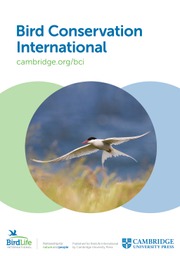No CrossRef data available.
Article contents
Wire marking reduces bird collisions with a transmission powerline in western Belgium
Published online by Cambridge University Press: 30 September 2024
Summary
Collisions with powerlines affect birds worldwide, including countries such as Belgium where a nationwide model indicated high avian collision risk in the IJzerbroeken region (seasonally flooded riverside wetlands). Large numbers of waterbirds winter in this area, which is crossed by a 70-kV transmission line. To manage avian collision risk, the transmission system operator, Elia, installed AB Hammarprodukter’s FireFly™ FF line markers incorporating reflective, glow-in-the-dark, high contrast, and moving elements intended to increase the visibility of the transmission line to flying birds. We evaluated the effectiveness of FireFly line markers by comparing the numbers of avian carcasses found during 11 surveys annually in 2001 and 2018 (22 total surveys) before line markers were installed compared with 11 surveys conducted in 2021 after line marking. Before line marking, we found 30 avian carcasses attributable to collision in 2001 and 113 in 2018. After, we found six carcasses attributable to collision in 2021. In 2021, FireFly line markers correlated with a reduction in collision rate, depending on the pre-treatment year and species group, of at least 85% and up to 100%. The line was composed of two configurations, with half of the spans (two-thirds of the monitored line length) supported by tall pylons with shield wires, and half of the spans supported by shorter pylons without shield wires. After line marking, six collisions (100% in 2021) occurred on spans supported by tall pylons, and none (0%) occurred on spans supported by short pylons. Thus, in 2021, FireFly line markers correlated with an observed mortality reduction of at least 73% and up to 100%, depending on the configuration being considered. These findings suggest FireFly line markers substantially reduced wintering bird collisions in our study area.
- Type
- Research Article
- Information
- Copyright
- © The Author(s), 2024. Published by Cambridge University Press on behalf of BirdLife International


